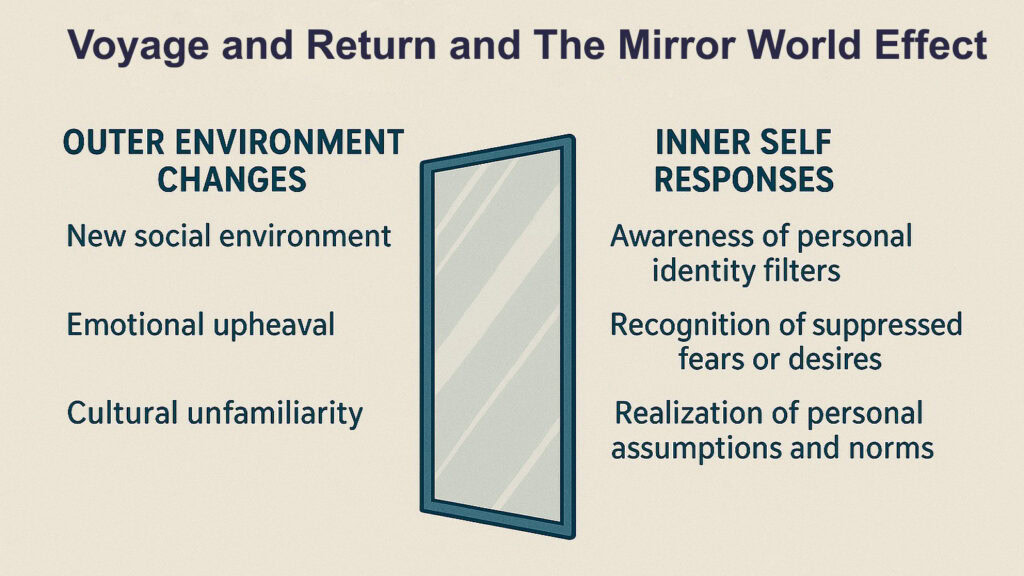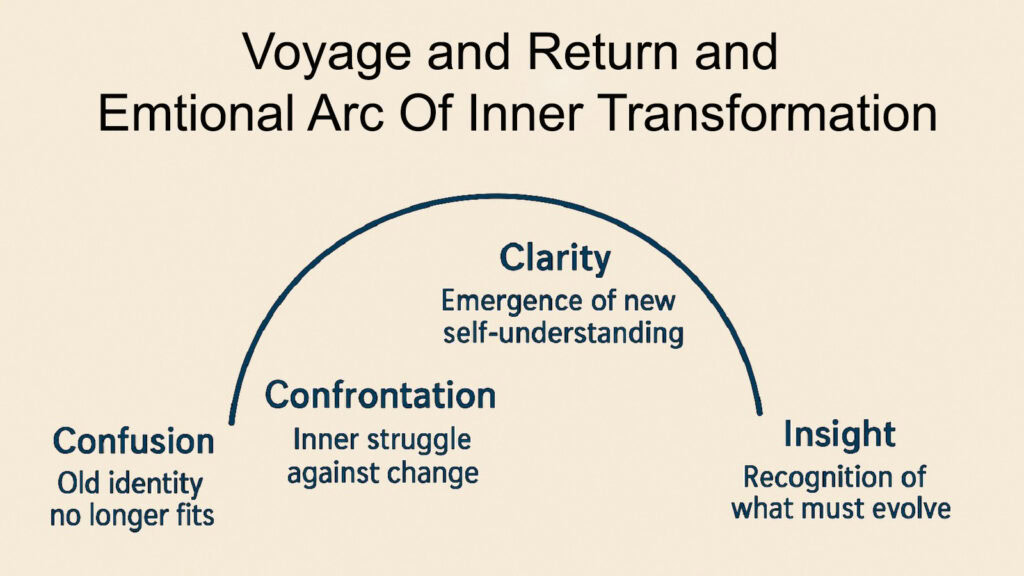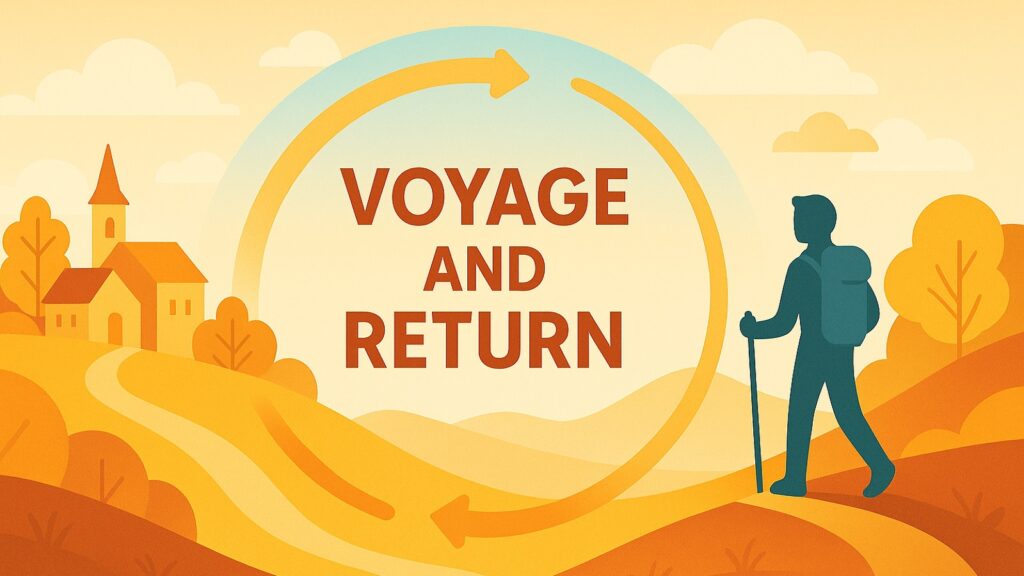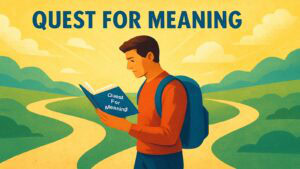Table of Contents
Introduction: Voyage and Return — Why We Leave to Become Who We Are

There exists a rhythm in human experience that predates written language. We leave what we know, encounter what we do not, and return changed by the journey. This is not a metaphor but a pattern, woven into the fabric of how we grow. The Voyage and Return stands among the most enduring story archetypes because it mirrors something essential about transformation itself.
In the Odyssey, a warrior spends years trying to reach home. In the Mahabharata, princes wander forests during exile, learning what kingship truly means. The Heike Monogatari traces the fall of a clan and the wandering that follows loss. These stories do not simply recount adventures. They map the territory between who we were and who we become. The voyage is always more than the distance traveled. It is the space where the familiar self dissolves and something new emerges in its place.
What makes Voyage and Return distinct is its circular nature. Unlike quests that seek external treasures or battles against monsters, this archetype turns inward. The journey out creates the conditions for the journey back. Home becomes the destination only after we have left it behind. Odysseus must sail away from Ithaca to understand what Ithaca means. Arjuna must leave his kingdom to see his duty clearly.
The pattern repeats across cultures because it reflects universal human experience. We leave relationships, careers, beliefs, and versions of ourselves. We enter unfamiliar territory where old certainties no longer hold. We struggle, adapt, and eventually find our way back to the familiar world, but we see it through different eyes. The archetype captures not just physical journeys but emotional and spiritual ones. It describes the shape of growth itself.
Understanding Voyage and Return means recognizing it in our own lives. Every significant change follows this rhythm. We step away from comfort, face what we avoided, and return transformed. The pattern continues throughout our lives, repeating in different forms. Each departure teaches something new. Each return integrates what we learned.
Comparison Between Voyag and Return and Other Story Archetypes
| Story Archetypes | Core Pattern |
|---|---|
| Voyage and Return | Departure from the familiar, transformation in the unknown, and return with new understanding |
| Rags to Riches | Movement from hardship to prosperity through perseverance and fortune |
| Quest For Meaning | Search for purpose or truth that reshapes identity and values |
| Overcoming The Monster | Confronting external threats that test courage and reveal inner strength |
| Power of Connection | Relationships and bonds that transform isolation into belonging |
| Rebirth and Revelation | Sudden insight or awakening that dissolves old identity and creates new awareness |
1. Voyage and Return: Leaving the Familiar and Crossing the Threshold
The moment before departure carries weight. Everything about to change already feels different, even though nothing has moved yet. Life rarely asks permission before demanding we step away from what we know. Sometimes the call arrives as an opportunity, sometimes as a crisis. A relationship ends, a job disappears, a belief crumbles. The familiar world that once held us stops fitting the shape we have become.
Crossing the threshold means accepting that returning to the old way is no longer possible. This is not always dramatic. It can be quiet, almost ordinary. Packing a suitcase for a city you have never seen. Sitting in silence after difficult news. Realizing the person you loved has become someone you no longer recognize. The threshold exists wherever comfort ends and uncertainty begins.
Odysseus sets sail from Troy knowing the journey home will be long. He does not yet know how long or what it will cost. Arjuna enters the forest during exile, leaving behind his brothers, his kingdom, and the certainty of his role. The departure strips away context. Without a palace or army, who is a prince? Without a home or crew, who is a hero? These questions cannot be answered from within the familiar. They require distance and difficulty.
The emotional truth of leaving lies in vulnerability. We step into the unknown, carrying only who we have been, uncertain whether that will be enough. Every departure involves a small death of the self that stayed behind. The student who leaves home, the widow who rebuilds alone, the believer who questions everything they were taught. Each crosses a threshold that cannot be uncrossed.
What makes this moment powerful is its honesty. We do not yet know what transformation awaits. We only know we must go. The Voyage and Return begins here, in this space between what was and what will be. The familiar fades behind us. The unknown stretches ahead.
Voyage and Return and The Emotional Landscape of Departure
| Dimension of Leaving | Internal Experience |
|---|---|
| Physical Separation | Letting go of places and routines that anchor identity |
| Emotional Detachment | Releasing relationships and connections that once defined belonging |
| Psychological Shift | Questioning beliefs and assumptions that shaped understanding |
| Identity Uncertainty | Losing social roles that provided purpose and recognition |
| Fear of Unknown | Facing vulnerability without familiar supports or guides |
| Hope and Dread | Holding both possibility and loss in the same moment |
2. Voyage and Return: Entering the Unknown and Facing the Mirror World

The strange world reveals more than it conceals. Every unfamiliar place, person, or situation acts as a mirror, reflecting what we carry inside but rarely see. This is the mirror effect at work. The challenges we face outside echo conflicts we have avoided within. The journey becomes interior even as it moves through exterior space.
When we enter the unknown, we lose the script. Old responses no longer work. The masks we wore in familiar settings slip away. In the Iliad, Achilles confronts honor through grief and rage. His fury at Agamemnon mirrors his fear of mortality. The battlefield becomes a space where internal struggles take external form. He fights enemies outside but battles questions inside about what glory truly means.
The mirror world does not need to be foreign lands or epic conflicts. It can be a new city where no one knows your name. A relationship that demands honesty you have never practiced. A failure that strips away illusions about competence. Any situation that removes familiar supports forces us to see ourselves more clearly. We encounter who we are when the props are taken away.
This stage of Voyage and Return carries particular weight because transformation begins here, though we may not recognize it yet. The discomfort we feel is not just circumstantial. It is the friction between who we were and who we might become. The unknown world presses against our edges, revealing where we are rigid and where we might bend.
The emotional arc shifts in this phase. Initial anxiety or excitement gives way to something deeper. We begin to see patterns in our reactions. Why does this situation anger us? What does our fear protect? The mirror shows not just reflection but revelation.
Voyage and Return and Dimensions of the Mirror World
| Aspect of Unknown | What It Reflects |
|---|---|
| Unfamiliar Settings | How much identity depends on external validation and context |
| Unexpected Challenges | Hidden assumptions about capability and worthiness |
| New Relationships | Patterns of connection and disconnection we repeat unconsciously |
| Cultural Differences | Unexamined beliefs about what is normal or right |
| Loss of Status | How much self-worth relies on recognition from others |
| Solitude and Isolation | The internal voices we usually drown out with activity |
3. Voyage and Return: The Trials That Reshape Identity
Hardship does not build character so much as reveal its architecture. Trials in the Voyage and Return serve a specific purpose. They apply pressure until something essential breaks or bends. What breaks needed breaking. What bends grows stronger through flexibility. The process is neither random nor cruel. It is how transformation actually works.
The Heike Monogatari traces warriors and nobles through defeat and exile. Their losses are not obstacles on the way to victory. They are the journey itself. In wandering and poverty, they discover what nobility means when stripped of power. Identity built on status crumbles. Something quieter and more durable emerges in its place. The trial reshapes not by adding but by removing everything that was never truly them.
The Mahabharata places its princes in impossible situations. Dharma, the right action, becomes unclear when duty conflicts with love, justice with mercy. Arjuna faces this complexity before Kurukshetra. The trial is not physical danger but moral ambiguity. He must act without certainty, choose without knowing which choice is correct. This reshapes him from a warrior who follows orders to someone who understands the weight of choice itself.
Our own trials rarely feel meaningful while we endure them. They feel like suffering, confusion, or a setback. The reshaping happens beneath awareness. We adapt to survive. We question to understand. We let go because holding on hurts too much. Each adaptation, question, and release carves away at the person we used to be. Identity becomes more flexible or more focused, depending on what the trial demands.
The emotional intensity of this stage can overwhelm. Everything that seemed stable proves temporary. Skills that once defined us stop working. Relationships that anchored us shift or end. The self we knew dissolves. This dissolution feels like failure but is actually a process. Transformation requires space. Old forms must clear before new ones can take shape.
Voyage and Return: How Trials Transform Identity
| Type of Trial | What It Dismantles | What It Builds |
|---|---|---|
| Physical Hardship | Illusions of invulnerability and control | Resilience and acceptance of limitation |
| Moral Ambiguity | Rigid beliefs about right and wrong | Capacity for nuanced judgment and compassion |
| Loss and Grief | Attachment to permanence and certainty | Ability to hold change and impermanence with grace |
| Isolation | Dependence on external validation | Internal sense of worth and direction |
| Failure and Humiliation | Pride and fixed ideas about competence | Humility and willingness to learn from mistakes |
| Betrayal | Naive trust and innocence | Discernment and deeper understanding of human complexity |
4. Voyage and Return: The Moment Transformation Begins Within

Voyage and Return has a transformational power. But the transformation does not announce itself. It arrives quietly, often unnoticed until much later. There is no lightning bolt, no dramatic revelation. Instead, something shifts in how we see. A situation that once provoked anger now invites curiosity. A fear that once paralyzed now seems manageable. The change begins so subtly that we might miss it entirely.
Odysseus spends years trying to reach Ithaca through strength and cleverness. These served him in war but failed him on the journey home. Slowly, without ceremony, he learns something else. Home is not a conquest. It cannot be seized or won. It requires patience, humility, and recognition of forces larger than himself. This realization does not come all at once. It accumulates through repeated failures and small moments of clarity.
The emotional arc of Voyage and Return bends here from confusion toward understanding. Not a complete understanding, but movement in that direction. We begin to integrate what the trials taught. The mirror world showed us patterns we could not see before. The hardships revealed what needed to change. Now, incrementally, we start changing it.
This internal shift manifests in small ways first. We respond differently to familiar triggers. We make choices that surprise us. We notice we have been carrying something heavy and realize we can set it down. The transformation is not about becoming someone else entirely. It is about becoming more fully who we were always capable of being.
The danger in this phase is mistaking insight for completion. Understanding what needs to change is not the same as changing it. The internal shift creates possibility, not inevitability. We still must choose, repeatedly, to embody what we have learned. The voyage has prepared us for return, but the return itself remains ahead.
Voyage and Return and Signs of Internal Transformation
| Dimension of Change | Emerging Pattern |
|---|---|
| Emotional Response | Reflective and measured |
| Self-Perception | Fluid and evolving |
| Relationship to Control | Allowing and adapting |
| Understanding of Others | Compassionate and contextual |
| Response to Difficulty | Engagement with balance |
| Sense of Purpose | Internal alignment |
5. Voyage and Return: Returning Home to Face a Familiar World That Feels Different
The return carries unexpected difficulty. Home has not changed, but we have. Streets look the same, faces are familiar, routines continue as they always did. Yet everything feels different because we see it through transformed eyes. This dissonance between external sameness and internal difference creates its own challenge.
Odysseus returns to Ithaca disguised as a beggar. The disguise is practical, but it also represents a deeper truth. He is not who he was when he left. The palace remains, his wife endures, but he must reenter this world as someone new. The return is not a triumphant homecoming but a careful negotiation between who he has become and the life waiting for him.
Arjuna returns from exile to face Kurukshetra. The battlefield is not a metaphor in his case, but the emotional truth holds. He comes back to familiar duty, familiar people, familiar expectations. Yet he sees it all differently now. What once seemed clear has become complex. His return forces him to integrate wandering wisdom with immediate responsibility. The war he faces is external, but the greater challenge is internal.
This phase of Voyage and Return tests whether the transformation was real or temporary. Familiar patterns have gravity. Old relationships pull us toward old versions of ourselves. The world that knew us before may not recognize or accept the person who returned. We face pressure to fit back into the shape we left behind.
The emotional experience of return is often lonelier than the voyage itself. In the strange world, we expected to feel out of place. Home should feel like belonging, but instead, we feel like strangers in familiar territory. The people we love may not understand what changed or why. They want who we were, not who we have become.
Voyage and Return: The Challenges of Return
| Aspect of Homecoming | Experience |
|---|---|
| Recognition | Feeling fundamentally changed |
| Relationships | Wanting deeper connection |
| Purpose | Seeking alignment with new values |
| Communication | Having different language for experience |
| Integration | Holding journey wisdom |
| Belonging | Questioning if you still fit |
6. Voyage and Return: Living the Transformation Every Day
Transformation matters only when lived. Insight that remains intellectual changes nothing. Voyage and Return taught us something essential, but that teaching must translate into daily action. This is integration, and it is often harder than the voyage itself. A dramatic change in crisis is easier than a consistent change in ordinary life.
Living transformation means making different choices in familiar situations. The pattern that once triggered us now invites pause. The relationship that once drained us now receives boundaries. The work that once defined us now takes an appropriate proportion. Each choice to embody what we learned on the journey reinforces a new identity.
Integration happens in small moments more than grand gestures. How do we respond when frustrated? Whether we honor the boundaries we set. If we maintain practices that support who we have become. The transformation becomes real through repetition. New patterns must be practiced until they replace old ones.
Reflective practices support this process without guaranteeing it. Journaling creates space to notice patterns and track changes. Stillness practices allow internal shifts to settle and deepen. Intentional action means choosing behavior aligned with transformed values rather than defaulting to old habits. These tools matter, but only when used consistently.
The Voyage and Return does not end with the return. It cycles. We integrate one transformation and eventually find ourselves at another threshold. A new leaving, a new unknown, a new set of trials. Each cycle builds on the previous one. The pattern repeats throughout life because growth itself is cyclical.
What matters most is whether we remain open to the journey. Some people resist after one difficult voyage, closing themselves off to future transformation. Others recognize the pattern and meet each new threshold with less fear and more trust. They understand that leaving, struggling, and returning is not an interruption of life but its essential rhythm.
Voyage and Return and Daily Integration of Transformation
| Practice | Purpose |
|---|---|
| Morning Reflection | Set intention aligned with transformed values |
| Boundary Maintenance | Honor limits discovered through journey |
| Pause Before Response | Create space between trigger and reaction |
| Regular Solitude | Maintain connection to internal shift |
| Meaningful Action | Embody new understanding through behavior |
| Evening Review | Track alignment between values and actions |
Conclusion: Voyage and Return — The Journey That Continues Across a Lifetime

The pattern of Voyage and Return never truly ends. We leave and return and leave again. Each cycle brings different lessons, different trials, different transformations. A relationship ends, and we journey through grief back to wholeness. A career collapses, and we wander through uncertainty toward a new purpose. A belief system crumbles, and we search through doubt toward deeper understanding.
Voyage and Return describes not just external journeys but the rhythm of growth itself. We cannot transform without leaving what we know. We cannot integrate without returning to apply what we learned. The archetype captures this essential movement. It reminds us that discomfort and uncertainty are not signs we have lost our way but evidence we are on the journey.
The stories that have survived centuries teach us something we often forget. The Odyssey, Mahabharata, Iliad, and Heike Monogatari all trace this same pattern because it reflects universal human experience. Warriors and princes, nobles and wanderers, all follow the same arc. They leave, change, and return. The details differ, but the shape remains constant.
The Voyage and Return offers no easy comfort. Transformation is difficult. Leaving hurts. The unknown frightens. Trials break us. Return disappoints. Integration demands daily effort. Yet this is how we grow. This is how we become more fully ourselves. The journey that takes us away from home is the only path that truly brings us home.
Voyage and Return and Shared Themes Across Epic Narratives
| Epic | Transformation Gained |
|---|---|
| Odyssey | Understanding that homecoming requires humility and patience, not conquest |
| Mahabharata | Clarity about dharma through moral complexity and the weight of choice |
| Iliad | Recognition of human limitation and the true cost of glory |
| Heike Monogatari | Discovery of what endures when status and certainty are stripped away |




